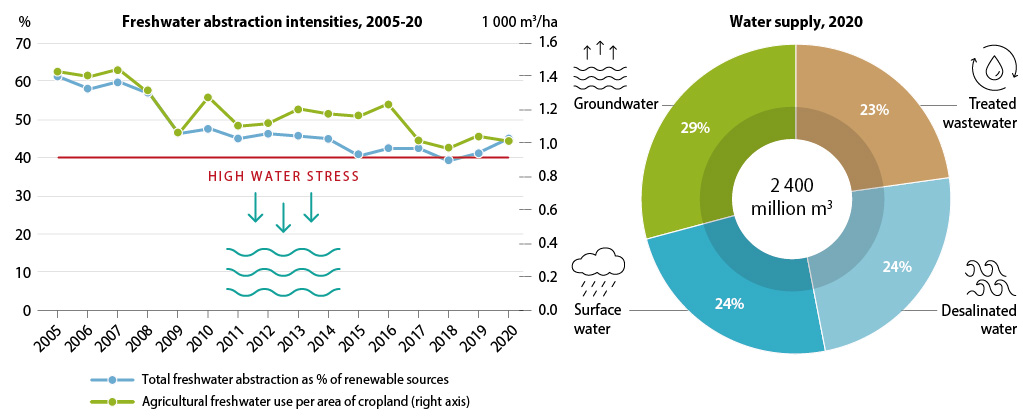Environment Focus
An environmental lens on policies for better lives
A global pioneer addressing water scarcity – how can Israel face other pressing environmental challenges?
by Sho Yamasaki, OECD Environment Directorate

Israel is one of the world’s most arid countries, but its small open economy is fertile ground for tech-driven innovation. The country boasts the highest concentration of start-ups per capita in the world. Tech start-ups and their dynamic ecosystem in Tel Aviv represent Israel’s increasingly vibrant economic scene. Technological innovation has also contributed to addressing environmental issues, such as water scarcity. The adage “necessity is the mother of invention” couldn’t be more apt; Israel’s high water-stress has helped propel the country to the forefront of innovation for sustainable water management. Its five desalination plants are among the most efficient in the world, supplying over 80% of domestic urban water. Large-scale reuse of wastewater and drip irrigation technologies have promoted sustainable water usage for agriculture.
In other environment domains, however, Israel lags behind peers. Its fast economic and population growth, along with a high degree of urbanisation continue to put significant pressure on the environment. The 2023 OECD Environmental Performance Review of Israel examines Israel’s environmental progress over the past decade and highlights challenges such as climate change, air and water pollution, biodiversity protection and waste management and circular economy.
New measures are needed for ramped up climate targets
Carbon emissions in Israel declined only recently after a steady increase between 2014 and 2020. Both total and per capita greenhouse (GHG) emissions have decoupled slowly from GDP growth, mostly due to the rapid replacement of coal by natural gas in the energy mix.
At the same time, Israel has raised its climate ambitions in recent years. It has set an 85% GHG reduction target for 2050 compared to 2015, as well as sectoral targets for GHG emissions, before declaring the overall ambition of carbon neutrality by 2050. However, cutting emissions by 27% in 2030 and 85% in 2050 will require new measures.
Figure 1. Meeting the 2030 and 2050 climate targets calls for additional measures

Note: GHG emissions exclude land use, land-use change and forestry. Dashed lines refer to emission projections according to the business-as-usual (BAU) scenario. Dotted lines refer to trajectories towards 2030 and 2050 GHG reduction targets with abatement measures according to Government Decision 171/2021.
Sources: Country submission; Government of Israel (2021), Updated Nationally Determined Contribution under the Paris Agreement; OECD (2022), “Air and climate: GHG emissions by source”, OECD Environment Statistics (database); UNFCCC (2022), Israel National GHG Inventory 2021.
Electricity production is the largest source of GHG emissions, followed by transport. Despite being an innovation leader, Israel’s share of renewables in the energy mix (5%) was the second smallest in the OECD (average 12%) in 2021, due to barriers such as limited land availability. It needs a medium-term investment plan for the production, storage and transmission infrastructure for solar-based electricity, mindful of the need to preserve open spaces and biodiversity. While the country had some success in promoting public transportation such as railways, it needs further investment in charging infrastructure for electric vehicles, in collaboration with local authorities, to address their slow uptake.
Stronger policies could help to protect human health and increasingly fragile ecosystems
Air pollution has improved but persists in several parts of the country. Emissions of all key air pollutants have been steadily declining over the last decade due to reduced combustion of coal and the implementation of the 2011 Clean Air Law. However, Israel’s population exposure to fine particulate matter (PM2.5), a danger to human health, was the fourth highest among OECD countries in 2019. The 2022 national programme for the reduction of air pollution sets new emission reduction targets for 2030.
Optimising water distribution from various sources has been a success. Israel is the largest user of recycled effluent water for agriculture across OECD countries; desalination secures the country’s supply of drinking water.
Figure 2. Israel’s wastewater reuse and seawater desalination are reducing freshwater scarcity

Note: Panel A – Water stress = total freshwater abstraction as percentage of total renewable water resources. A water stress higher than 40% indicates serious water scarcity and shows unsustainable water use.
Source: CBS (2021), “Water and sewage”, Statistical Abstract of Israel 2021 – No 72; OECD (2022), OECD Environment Statistics database).
However, policies are needed to address water quality. Both surface water and groundwater remain polluted. Reducing nutrient loading from agriculture through stricter requirements for fertiliser application, taxes on fertilisers and awareness raising and training for farmers, as well as complete upgrades of its wastewater treatment infrastructure are all key.
The increasing demand for new housing and infrastructure is exerting pressure on the country’s rich biodiversity. Israel is making progress in expanding protected areas. However, most vulnerable ecosystems are under significant stress outside protected areas. The country should pursue better mainstreaming of biodiversity protection into sectoral policies and intensify efforts to protect terrestrial ecosystems outside national parks and nature reserves.
Moving towards “zero waste” by 2050
Israel aspires to “zero waste” by 2050. However, sustained economic and population growth over the past decade, in the absence of robust waste management policies, have contributed to growing municipal solid waste (MSW) levels. While the share of both landfilling (80%) and recovery (20%) have remained stable over 2010-20, the Sustainable Waste Economy Strategy aims to reduce the share of total MSW landfilled to 20% by 2030.
Figure 3. Waste generation and the landfilling rate have increased since 2010

Note: Municipal waste includes household waste and similar waste collected by or on behalf of municipalities. It includes bulky waste and excludes construction waste and sewage waste. Breakdown data for recycling and composting are available from 2013.
Sources: CBS (2022), Waste and Recycling (database); OECD (2022), “Waste: Municipal waste”, OECD Environment Statistics database).
Waste management policy tools must be leveraged to their full extent. Existing economic instruments for waste management do not provide sufficient incentives for behavioural change and to drive investment more sustainable approaches. For instance, the total cost of landfilling in Israel is lower than that of more sustainable treatment methods such as incineration with energy recovery. Israel could implement the pay-as-you-throw scheme more broadly to provide stronger incentives for waste prevention and recycling.
Both technological and non-technological solutions are required to tackle the environmental challenges
Israel, like most countries, must confront a number of environmental challenges. While technology provided a strong impetus behind Israel’s solid performance in addressing water scarcity, on its own, technology cannot tackle all environmental issues. For instance, nature-based solutions can help prevent drought or other hazard events in the context of climate change. The engagement of civil society, local governments and community-based organisations is critical in improving waste management systems for instance. For industry and businesses, innovation in business model such as product-as-a-service could enhance their circularity. Complemented by Israel’s technological prowess and robust policy tools, they provide a pathway to effectively tackle the country’s most pressing environmental challenges.

On 31 May 2023, the OECD released its second Environmental Performance Review of Israel. The review provides 24 recommendations to help Israel further improve its environmental performance, with a special focus on waste management and circular economy.
Further reading
OECD (2023), Environmental Performance Reviews: Israel 2023, http://oe.cd/epr-israel .
- Israel’s country profile: https://www.oecd.org/israel/.
- OECD (2023), OECD Economic Surveys: Israel 2023, OECD Publishing, Paris, https://doi.org/10.1787/901365a6-en.
- Israel’s sustainable water management plans, IPAC | International Programme for Action on Climate – OECD.
- OECD Environmental Performance Reviews programme.
Photo credit: Shutterstock / vvvita
